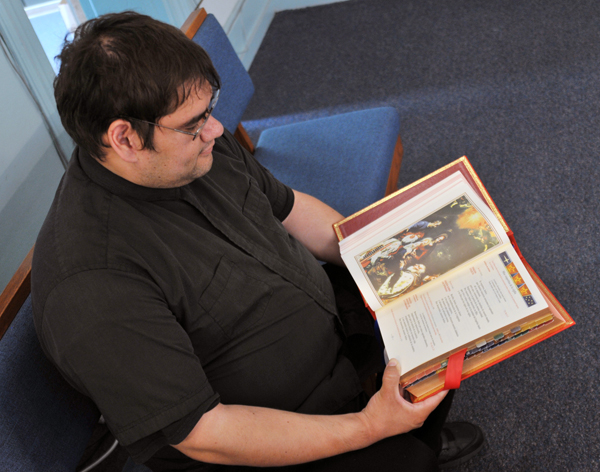By Lindsay Steele
The Catholic Messenger
The United States Conference of Catholic Bishops (USCCB) has released “Misal Romano, tercera edicion,” the first-ever Spanish language Roman Missal created and approved for use in the U.S. church.

Father Guillermo Trevino looks through his copy of “Misal Romano, tercera edicion” earlier this month at St. Mary Parish in Davenport. It’s the first-ever Spanish language Roman Missal created and approved for use in the U.S. church.
The new Missal, released May 1, closely mirrors the third edition of the English-language Roman Missal, which was released in 2011. The USCCB began the process of creating and approving a Spanish missal shortly after the release of the new English missal.
Deacon Frank Agnoli, director of liturgy for the Diocese of Davenport, believes the release of the Spanish missal is a major milestone for Spanish-speaking Catholics in the United States. “It’s an enormous, huge commitment on behalf of the U.S. church to do this,” he said. He sees it as a sign that the U.S. church supports and embraces Spanish-speaking Catholics who wish to celebrate Mass and pray in their native tongue.
Until recently, if a priest in the United States wanted to offer Mass in Spanish, he had to use an approved Spanish-language Roman Missal from another country, such as Spain, Mexico or Peru. Priests in the Davenport Diocese said they found this to be a bit of a headache due to consistency issues with the English-language Roman Missal and differences in dialect, among other things.
When the USCCB first announced the release date back in October, Father Guillermo Trevino was excited. “It sounds like we FINALLY have an approved U.S. version of the third edition of the Roman Missal in Spanish,” he said in an email to the other Spanish-speaking priests in the Davenport Diocese. The Spanish Missal from Mexico, which he was using for Spanish Masses at St. Mary Parish in Davenport, was falling apart. He was also growing frustrated with having to ad-lib parts of the U.S. Mass which are not included in the Mexican missal.
Fr. Trevino’s brother priests expressed similar optimism at the diocesan Hispanic Ministers meeting in mid-May. Some had received the new missal, while others were waiting for their copy to arrive in the mail. Parishes have until the first Sunday of Advent to begin using the new missal during Spanish Masses.
The priests noted that one of the biggest advantages of the new missal is that it uses language that the average Spanish speaker in the United States speaks and understand. For example, Spanish-speakers in the United States rarely use the pronoun “vosotros” (you, plural), which is used in the Spanish-language Roman Missals for other countries. Generally, priests in the Davenport Diocese substitute the more commonly used “ustedes” as permitted by the Vatican.
They’re also thrilled that the new missal incorporates U.S. feast days and popular feast days from south of the border. The first appendix is all new — it contains the Mass texts and Lectionary citations for the patronal feasts of 20 of the countries of origin for Spanish-speaking immigrants to the United States. This offers Spanish-speaking Catholics in the United States “a taste of home,” while also introducing them to popular U.S. traditions, Deacon Agnoli said. Fr. Joseph Sia said, “This new missal makes a conscious effort of incorporating the Spanish-speaking communities into the liturgical celebrations of the United States.” Fr. Sia is the pastor of St. Joseph Parish in Columbus Junction.
Fr. Sia also observes that the new missal contains musical notations that can be used to sing parts of the Mass in Spanish. “This will be very helpful for priests and congregations to sing the different Mass parts, such as the dialogues (e.g. “The Lord be with you”/ “El Senor este con ustedes” and people respond, “And with your spirit”/”Y con tu espiritu”). Another practical application I see here is for weekday — or even Sunday — Masses in Spanish where there is no choir or musician. I now have resources to use to teach the congregation to sing the Mass parts such as the “Holy, Holy, Holy.”
According to the priests, there’s just one drawback to the new missal, and it’s a minor one: the size and color of the Spanish missal is almost identical to the English missal. This means that altar servers who were used to carrying missals of different sizes and colors will need to make sure they don’t accidentally grab the wrong missal during Mass.
Father Jim Betzen, C.PP.S., celebrates Spanish Masses at St. Mary Parish in Ottumwa, where he serves as pastor. He feels blessed to have the new edition at his fingertips. “I have been a priest for 37 years and in Hispanic ministry for 35 years. I am grateful to finally be able to celebrate the Mass with the new Misal Romano for Hispanic communities in the United States.”
“Having a new missal revitalizes the liturgy,” Fr. Trevino said.
Hispanics/Latinos in the Diocese of Davenport
A study by Our Sunday Visitor reports that, nationally, 55 percent of U.S. Catholics under the age of 30 are Hispanic, and 25 percent of all Catholic parishes have Hispanic ministry. Since 1960, Hispanics account for 71 percent of the growth of the Catholic population of the United States.
Weekly Mass in Spanish is offered at seven parishes in the Diocese of Davenport: St. Mary-Davenport; Ss. Mary & Mathias-Muscatine; St. Joseph-Columbus Junction; St. Patrick-Iowa City; St. Mary of the Visitation-Ottumwa; St. Joseph-West Liberty and St. James-Washington. Parishes offering Spanish Masses once a month are Prince of Peace-Clinton and St. Alphonsus–Mount Pleasant.
Approximately 1,480 people participate in Spanish Masses each week in the Davenport Diocese, with an additional 135 attending the monthly Masses, according to recent Mass counts. In diocesan Catholic schools, 474 kindergarten-through-eighth-grade students and 93 high school students identify as Hispanic or Latino.












Is there a Sunday Missal written in both English and Spanish side by side like the old Latin missals?
To my knowledge they are two separate books.
Some missalettes (the ones in the pews) do have side by side, but that’s just for scripture readings and the psalms. Not the big red book the priest uses.
-Lindsay Steele
Any update on the availability of a side-by-side Spanish/English Alter Sunday Missal?